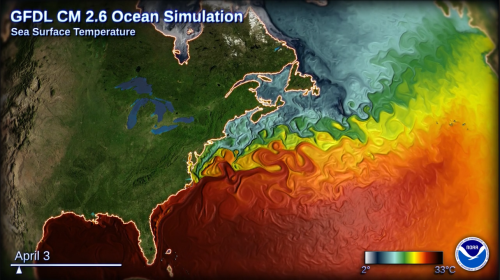High-resolution Modeling
High resolution improves model accuracy and allows important small-scale processes to be simulated, reducing dependence on uncertain parameterizations. Model resolution is limited by computing power. Climate models are carefully designed to “fit” into a target computer.
High-resolution Atmosphere Modeling
Much of the most destructive behavior of the atmosphere occurs at scales of a few hundred down to a few kilometers. However, many high-impact weather events cannot be directly simulated in low-resolution climate models. Hurricanes only appear as weak lows in low-resolution models, and severe thunderstorms do not appear at all. Less intense but no less important are persistent features due to small-scale topography. Much of the precipitation in mountainous regions, so often critical for water supply in the surrounding region, is forced by small, steep slopes. Even larger-scale climate patterns are affected by smaller-scale features. Drag and blocking by mountains critically alters the global circulation of the atmosphere, and gravity waves caused by tropical thunderstorms cause a reversal of stratospheric winds about every 13 months.
High-resolution Climate Modeling

GFDL’s CM2.1 climate model, incorporating 1o ocean and 2o atmospheric components, was developed to produce output and science for the IPCC 4th assessment report. When evaluated over a broad suite of metrics this model was found to produce a high quality simulation of the present-day climate and its variability. In addition to other applications, GFDL uses the CM2.1 model for experimental seasonal predictions as part of the North American Multi-Model Ensemble (NMME).
High-resolution Ocean Modeling
The ocean mesoscales are largely dominated by baroclinic eddies, fronts, and boundary currents and they have length scales between roughly 10km-150km. Mesoscale flows are the primary cause for the ocean transport of heat, carbon, nutrients, momentum, vorticity, and other properties. However, they are extremely difficult to explicitly represent in global climate models due to their relatively small scales (about 10-times smaller than the analogous synoptic atmospheric eddies). Furthermore, the submesoscales (1km-10km) are emerging as an important dynamical regime due to their impacts on vertical motion in the upper ocean and for providing a dynamical connection to the even smaller scales where mixing and dissipation occurs. Dynamical processes at the mesoscales and submesoscales are relevant for understanding and modeling interactions near the coasts, including upwelling of nutrients for ecosystems and the movement of ocean heat under high latitude ice-shelves that can have important implications for sea level.


